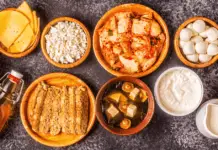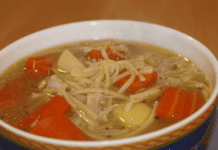Have you been searching for a gluten-free all-purpose flour blend to use in your baking and cooking recipes? This article will show you how to make a DIY gluten free flour blend at home, and with little effort.
This post contains affiliate links. If you make a purchase through a link, I may receive a small commission, at no cost to you.

Whether you have Celiac disease, are gluten-sensitive, or just want to experiment with a gluten-free alternative, this DIY gluten free flour blend will suit your needs.
Store-bought gluten-free flour blends can include a confusing assortment of ingredients. For ultra sensitive people like myself, the risk of a reaction is real.
This all-purpose gluten-free flour blend uses a minimal amount of ingredients. It’s also versatile enough to be used in all your baking and cooking recipes.
In fact, with the addition of Xanthan Gum, I’ve substituted flour in many recipes with this gluten-free flour blend. Keep reading to learn more.
Table of Contents
What is Gluten-Free All-Purpose Flour?
Gluten-free all purpose flour contains a combination of gluten free flours that serve the same purpose as conventional flour. You can use it as a flour substitute for baking, frying, thickening, gravies, or whatever recipe you’re making.
The difference is it doesn’t contain the proteins or gluten typically found in wheat, rye and barley. This makes it a good alternative for people with Celiac disease and gluten-sensitivity.
Unlike conventional all-purpose flour which contains gluten, this gluten free alternative flour blend combines a variety of gluten-free flours to mimic the texture and functionality of wheat flour.
This homemade gluten free flour recipe can be used as a 1:1 replacement for all-purpose recipes. That means you can use equal amounts of this gluten-free flour blend as the recipe calls for.
.
When I first switched to a gluten-free diet, I thought I could use brown rice as a 1:1 replacement in all my baking recipes. Suffice it to say, my baked recipes came out dry, gritty and crumbly. That’s because rice flour absorbs moisture differently than other flours.
With a little research I learned that different flours have properties that make them more or less suitable for baking.
Common Ingredients in a homemade gluten-free all-purpose flour blend


Brown Rice Flour – The Foundation
The brown rice flour serves as a base in this gluten-free flour blend. Brown rice flour is made from rice that is finely ground.
Rice flour helps to give baked goods a fluffy, airy texture. It’s also responsible for giving baked goods its crunchiness.
Brown rice flour has been described as having a “nutty” flavor. The brown rice flour can be substituted with white rice flour which has a more neutral flavor.
I’ve only used brown rice flour. I’m sure the discerning taste bud can notice a difference between the 2 flours. But having no basis for comparison, I can’t say that I’ve noticed a nutty flavor in the brown rice flour.
For the health-conscious, brown rice flour makes a good choice.
In addition to fiber, brown rice flour contains iron, B-vitamins, and potassium and antioxidants. Brown rice flour is low in saturated fat so it helps reduce the risk of heart disease.
Nutritional value varies between brands. So If you’re looking for the biggest nutritional bang for your buck, you’ll want to read the labels.
For sensitive individuals, brown rice flour is easily digested and hypoallergenic.
Tapioca Flour – The Binder
Tapioca flour is not derived from grain like other flours. It’s extracted from cassava, a root vegetable found in South America.
The powdery flour is starchy and almost chalk-like in appearance and texture. You’ll want to be careful handling it as it can be messy.
Because of its excellent binding ability tapioca flour helps baked goods like cookies and cakes maintain their structure. It also gives baked goods their chewiness.
The high starch content makes it the perfect thickener for soups, stews, gravies and sauces.
Potato Starch – The Moisture Manager
Potato starch is made from white, peeled portion of the potato. It’s white and powdery in appearance. Because it absorbs moisture, it helps prevent baked goods from drying out. Like tapioca starch, it makes an excellent thickener.
Potato starch plays an important role in mimicking gluten’s elasticity when blended with other flours.
You May Also Want to Read
Best Gluten-Free Chicken and Dumpling Soup
Delicious and Easy Gluten-Free Christmas Cookie Recipes for the Holidays
19 Gluten-Free Valentines Treats to Make for Your Sweetie
Why is Xanthan Gum Often Added to Gluten-Free Baked Goods


You may notice Xanthan gum listed on many gluten-free recipes. Xanthan gum binds or holds ingredients together. It provides structure. This keeps your beautiful cake from collapsing into a heap of crumbs on your plate.
Xanthan gum is made during the fermentation process of a specific bacteria. Xanthomomonas campestris is a bacteria that affects plants. It’s harmless to humans.
Before you get too skeeved out, we’re no strangers to bacteria in the food production process. Yogurt, cheese, sauerkraut, kimchi and yeast are just a few products made using bacteria.
When substituting wheat flour with this gluten-free flour blend, mix in ½ teaspoon for every cup. Too much Xanthan gum and your baked goods may become dense, gummy or have a slimy feeling in your mouth.
Individuals who are sensitive to Xanthan gum may experience GI upset when consuming foods prepared with it. Symptoms may include bloating, gas or diarrhea. If symptoms occur, discontinue use and try using an alternative binder.
The Perfect Blend – Your Homemade Gluten-Free All-Purpose Flour Blend


With this homemade gluten free flour recipe you can bake fluffy, airy, chewy, moist, structured treats that don’t fall apart. Or you can thicken your sauces, gravies, stews and puddings.
All 3 flours used in this flour blend are all low FODMAP. This makes them ideal for people with irritable bowel syndrome.
Using Your Gluten-Free All-purpose Flour Blend
I typically double this recipe and store in a large container on my kitchen counter.
As previously mentioned, this gluten-free flour blend can be used as a 1:1 replacement for all-purpose flour in your favorite homemade recipes.
To get consistent results, you’ll want to follow a few simple tips.
- Be sure to use precise measurements.
- Prior to baking, let your gluten-free doughs and batters rest momentarily. Resting gives dough a chance to firm up and batters time to thicken.
- Experiment. Tweak your recipe with more or less ingredients as needed. For example, if your cakes come out too dense, try using less Xanthan gum next time.
Should Gluten-Free Flour Be Stored in the Fridge?
It’s not necessary to refrigerate your gluten free all purpose flour blend, unless you live in a hot, humid climate. Then you’ll want to refrigerate it to keep it from going rancid. Otherwise, your gluten-free flour blend can be stored in a cool, dry place.
If you do decide to refrigerate, be sure your gluten-free blend has reached room temperature before using it in recipes. Baked goods can be affected by chilled flour.
Recommended Products
Bob’s Red Mill Gluten Free Brown Rice Flour
Large Airtight Storage Containers
Stainless Steel Measuring Cup and Spoon Set


Gluten-Free All-Purpose Flour Blend
Ingredients
- 1½ cups Brown Rice Flour
- ¾ cups Tapioca Flour
- ¾ cups Potato Starch
- Xanthan Gum (optional)
Instructions
- In a large mixing bowl, combine all the flours.
- Blend the flour with a whisk until evenly mixed.
- Store your gluten-free flour blend in an airtight container.
- For each cup of flour that the recipe calls for, add ½ teaspoon of Xanthan gum. However, if using this flour blend in a gluten-free recipe that already calls for Xanthan gum, use the amount suggested by the recipe.























